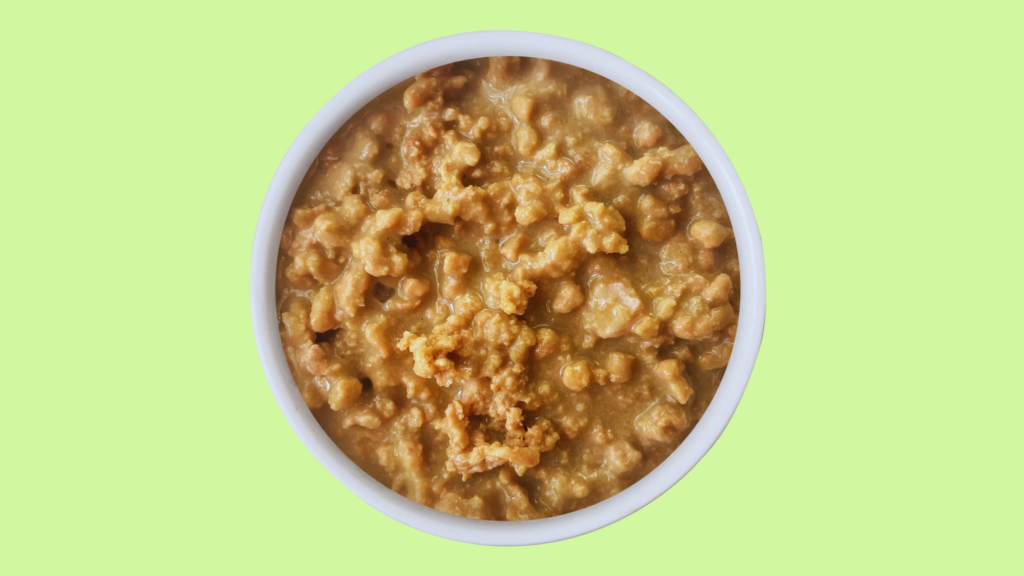| Summary: Cat food vs dog food: Cat food is rich in protein, taurine, and fat, essential for feline health, while dog food has more carbohydrates and lacks taurine, which cats need. Cats cannot thrive on dog food long-term, and dogs may gain weight on cat food due to its higher protein and fat content. |
Choosing the right food for your pet is one of the most important decisions you can make. Cats and dogs have vastly different nutritional needs, digestive systems, and dietary preferences. Cat food is specifically formulated for obligate carnivores, with high protein levels and essential nutrients like taurine and arachidonic acid, while dog food is designed for omnivorous diets that include a broader range of ingredients such as grains and vegetables. Dog food contains balanced nutrients tailored for canines, while cat food is too high in protein and fat. GPS dog collars can help prevent sneaky snack theft.
I will explore the key differences between cat food vs dog food—covering nutritional composition, texture, feeding frequency, caloric density, specialized nutrients, cost considerations, and practical feeding tips—to help you make informed decisions for your furry friends.
Ensure your Newfoundland’s comfort and security with expert tips on how to ensure a safe collar fit for Newfoundland.
Blog Highlights
ToggleCat Food vs Dog Food: Quick Comparison Table
| Factor | Cat Food | Dog Food |
| Nutritional Composition | High in animal-based proteins; rich in taurine, vitamin A, and arachidonic acid | Balanced blend of animal and plant-based proteins; includes carbohydrates and fibers |
| Digestibility & Texture | Fine kibble or pâté; soft textures in wet food to aid chewing and digestion | Larger kibble sizes; varied textures to suit different breeds and chewing habits |
| Feeding Frequency | Typically fed in small, frequent portions or free-choice feeding | Usually served in 1-2 scheduled meals per day, sometimes with treats as supplements |
| Caloric Density | High caloric density in a small serving due to smaller body size and high metabolism | Caloric needs vary widely; larger portion sizes designed for greater energy demands |
| Key Nutrients | Requires high levels of taurine, vitamin A, and omega fatty acids | Balanced nutrients with emphasis on energy from carbohydrates, moderate protein, and fiber |
1. Understanding Species-Specific Nutrition
When comparing cat food and dog food, it’s essential to recognize that cats are obligate carnivores—meaning their bodies require a diet predominantly made up of animal proteins and fats. Dogs, on the other hand, are more omnivorous, able to thrive on a varied diet that includes meat, grains, and vegetables. These inherent biological differences mean that each species has unique dietary needs that cannot be interchanged without risking nutritional deficiencies or health issues. The amino acids and vitamins in cat food differ from those in dog food, making it unsuitable for long-term feeding. Check out pet tech products for automated meal dispensing.
Both pet food types are created with their target species in mind. Manufacturers design cat food to support everything from high protein metabolism to the maintenance of a sensitive urinary system. Dog food, however, is formulated to meet the energy requirements of more active animals and to accommodate a digestive system that can process a more diverse array of ingredients.
2. Nutritional Composition: Tailoring the Diet to Biological Needs
Cat Food: For the Obligate Carnivore
Cats are built to thrive on a meat-based diet. Their evolutionary history as hunters has left them with specific nutritional requirements that must be met through their food. Dogs need a different calcium-to-phosphorus ratio than cats, making their food formulas unique. Electronic dog collars can help discourage bad eating habits.

- High Protein Content: Cat food is typically rich in animal proteins (often 30%–50%), which are crucial for muscle development and overall cellular function.
- Essential Amino Acids: Taurine, an amino acid found almost exclusively in animal tissue, is critical for heart, vision, and immune health in cats. Without sufficient taurine, cats can develop severe health issues.
- Fatty Acids & Vitamins: Cats require higher levels of omega-3 and omega-6 fatty acids (including arachidonic acid) and vitamins like A and D. Unlike dogs, cats cannot efficiently convert plant-based nutrients to these essential forms.
- Minimal Carbohydrates: Due to their evolutionary adaptation, cats have a limited ability to digest carbohydrates, so cat food typically contains very few grains or starches.
Dog Food: A More Versatile Approach
Dogs have evolved alongside humans for thousands of years and have adapted to a more varied diet. Their digestive systems can handle a mixture of proteins, carbohydrates, and fibers.

- Balanced Protein Levels: Dog food contains protein levels ranging from 18% to 30%, sourced from meat as well as plant proteins. This supports muscle maintenance and energy.
- Inclusion of Carbohydrates: Dogs can digest carbohydrates better than cats, so dog food often includes grains such as rice or barley, as well as vegetables, which provide a steady energy source.
- Variety of Nutrients: Dog food is designed to provide a balanced diet that includes vitamins, minerals, and antioxidants to support overall health. While taurine is important, dogs can synthesize some of it from other amino acids.
- Energy Density: Dogs come in a wide range of sizes and activity levels, so the formulation often varies to provide the appropriate energy density for small, active breeds as well as larger, more sedentary ones.
Discover the ideal fit by learning what size collar for Newfoundland dog to ensure your pet’s comfort and safety. Feeding a dog cat food can lead to digestive issues and nutritional imbalances. Use dog training equipment to establish proper food routines.
3. Digestibility and Texture: Designed for Different Dental and Gastrointestinal Systems
Cat Food: Soft, Fine, and Easy to Chew
Cats, with their small mouths and delicate teeth, benefit from food that is easy to consume and digest.

- Wet Food Variants: Many cat foods come in a pate or mousse form, which is soft and helps with hydration.
- Small Kibble Size: When dry food is offered, the kibble is often much smaller and finely milled to accommodate the cat’s chewing capacity.
- Moisture-Rich Formulations: Cats naturally have a low thirst drive, so the moisture in wet food aids in maintaining kidney health and overall hydration.
- Digestive Enhancers: Some cat foods include added enzymes and prebiotics to ensure optimal nutrient absorption and support a healthy gut microbiome.
Dog Food: Robust Textures for Varied Chewing Needs
Dogs come in a wide variety of sizes and have different chewing abilities, which is reflected in the diversity of dog food textures available.

- Larger Kibble and Chunky Cuts: Dog food is often manufactured in larger kibble sizes, designed for the robust jaws and stronger chewing forces of dogs.
- Varied Formats: Many dog foods come in both dry and wet forms. Dry kibble can help maintain dental hygiene, while wet food provides extra moisture and is sometimes preferred by dogs with dental issues.
- Digestive Adaptability: Dogs have a more flexible digestive system, allowing them to process a wider range of textures and ingredients without the same strict requirements as cats.
- Chew-Friendly Options: Some dog foods are designed with dental health in mind, incorporating abrasive textures that help reduce plaque and tartar buildup.
4. Feeding Frequency and Portion Sizes: Meeting Different Energy Demands
Cat Feeding: Small Meals for a Discerning Eater
Cats often prefer to graze or eat multiple small meals throughout the day. Their feeding habits are closely tied to their natural behavior as solitary hunters.
- Multiple Small Meals: Cats are typically fed in several small portions or allowed free access to food (free-choice feeding). This approach mimics their natural feeding behavior.
- Portion Control: Because cats have a small stomach capacity, even though they have a high metabolism, precise portion control is crucial to avoid obesity.
- Scheduled Feeding: For indoor cats or those prone to overeating, scheduled feeding times can help maintain a healthy weight and avoid excessive calorie intake.
Dog Feeding: Fewer, Hearty Meals
Dogs generally require larger portions of food less frequently than cats. Their feeding schedules are often more structured, aligning with their activity cycles.
- Once or Twice Daily Meals: Many dog owners feed their pets one or two large meals a day. This schedule suits dogs’ larger stomach capacities and their tendency to expend energy in bursts.
- Tailored Portions: Dog food portions are adjusted according to breed, size, activity level, and age. A highly active dog may require more calories, while a less active or older dog might need a lower-calorie diet.
- Supplementary Feeding: Some owners include treats or additional snacks between meals, especially for working or training dogs, ensuring that they receive the energy they need throughout the day.
5. Caloric Density and Energy Needs: Fueling Activity vs. Efficiency
Caloric Considerations for Cats
Cats require food that is highly concentrated in calories because of their smaller size but high metabolic rate. However, overfeeding can quickly lead to obesity, a common issue in domestic cats.
- High Caloric Density: Cat food is formulated to deliver concentrated nutrition in small portions—often around 350-450 kcal per cup in dry food formulations.
- Energy Efficiency: Because cats are natural hunters, they are efficient at utilizing the energy in their food, but their sedentary lifestyle (especially indoor cats) means portion control is essential.
- Hydration Impact: The moisture content in wet food adds an extra dimension to caloric intake, often providing lower calories per serving due to water weight.
Energy Needs in Dogs
Dogs come in a wide range of sizes, from tiny lap dogs to large working breeds, so their energy requirements vary considerably.
- Variable Caloric Density: Dog food is formulated in various caloric densities to meet the diverse needs of different breeds. Active breeds may require food with 400-500 kcal per cup, whereas less active or older dogs might do well on lower-calorie formulations.
- Larger Portion Sizes: Given their larger size and varied energy expenditures, dogs typically consume more food per meal compared to cats.
- Activity Levels: The overall energy output of a dog can be influenced by exercise, play, and work. Dog food formulas are often tailored to meet these dynamic energy needs.
For expert tips on how to fit a collar on a Belgian Shepherd, this guide offers simple steps to ensure your dog’s collar fits securely and comfortably.
6. Specialized Nutrients: What Makes Cat Food Unique?
Essential Nutrients for Cats
Cats have unique dietary requirements that set their food apart from dog food. Some of these nutrients are so critical that they must be included in a cat’s diet in a specific form.
- Taurine: Cats cannot synthesize sufficient taurine on their own. This amino acid is crucial for heart function, vision, and reproduction.
- Vitamin A: Unlike dogs, cats must consume preformed vitamin A, which is naturally found in animal tissues.
- Arachidonic Acid: This essential fatty acid is vital for skin health, inflammatory responses, and overall cell function in cats.
- Protein-Centric Diet: Cats need a higher percentage of protein derived primarily from animal sources, supporting muscle development and overall health.
Nutritional Considerations for Dogs
While dogs share some of the same nutrients as cats, their bodies are more adaptable when it comes to synthesizing certain compounds.
- Carbohydrates and Fiber: Dogs benefit from carbohydrates as an energy source. Fiber aids in digestion and helps regulate blood sugar levels.
- Flexible Protein Sources: Dogs can efficiently utilize both animal and plant-based proteins, which allows for a broader range of ingredients in their food.
- Balanced Fatty Acids: Dog food typically includes a balanced mix of fats to support coat health and provide energy, without the high levels required by obligate carnivores like cats.
- Versatile Vitamin Requirements: Dogs can convert certain precursors into the vitamins they need, giving manufacturers more flexibility in their formulations.
7. Cost Considerations: Investing in Quality Pet Nutrition
Price Factors in Cat Food
High-quality cat food often comes with a premium price due to the specialized ingredients and strict formulations required.
- Premium Ingredients: Sourcing animal-based proteins, taurine, and other essential nutrients can be costly.
- Small Portion Sizes: Because cats require less food by volume, the cost per serving can seem higher even if the total package price is lower.
- Health Investments: Feeding your cat a well-formulated diet may reduce long-term veterinary expenses by preventing diet-related health issues such as heart disease or kidney problems.
Economical Options in Dog Food
Dog food is available in a wider variety of price ranges, and bulk purchasing can often bring costs down without sacrificing quality.
- Variety of Formulations: There are many reputable dog food brands offering quality nutrition at different price points.
- Bulk and Family Packs: Larger bags and multi-dog households often benefit from economies of scale, making premium dog food more affordable.
- Preventative Savings: A balanced diet can prevent costly health issues later in life, making it a worthwhile investment even at a slightly higher upfront cost.
8. Practical Feeding Guidelines and Daily Tips
Establishing a Routine for Cats
Creating a regular feeding schedule for your cat can help maintain a healthy weight and support overall well-being.
- Scheduled Feeding: Rather than free-feeding, set specific meal times to control portion sizes.
- Measure Portions: Use a measuring cup to ensure that each meal delivers the right amount of calories.
- Monitor Behavior: Keep an eye on changes in appetite or weight, and adjust portions as needed.
- Hydration: Always provide fresh water, especially if your cat primarily eats dry food.
Feeding Tips for Dogs
Dogs thrive on routine and benefit from a structured feeding schedule that matches their energy output.
- Consistent Meal Times: Feed your dog once or twice daily at consistent times to help regulate their metabolism.
- Appropriate Portions: Portion sizes should be adjusted based on your dog’s breed, age, activity level, and overall health.
- Supplementary Treats: Use treats sparingly to reward good behavior or as training aids, ensuring that they do not significantly increase daily caloric intake.
- Mix It Up: Consider a combination of dry kibble and wet food to provide variety and ensure proper hydration, particularly for dogs that may not drink enough water on their own.
For detailed guidance on selecting the correct collar size for a Belgian Shepherd, this article provides essential tips to ensure your dog’s comfort and safety.
9. The Long-Term Impact of Proper Nutrition
Health Benefits for Cats
Feeding your cat a diet tailored to its specific needs can have profound effects on its long-term health.

- Improved Longevity: A balanced, nutrient-dense diet can help prevent chronic diseases such as heart conditions, kidney issues, and diabetes.
- Enhanced Quality of Life: Proper nutrition supports a shiny coat, healthy skin, and overall vitality, making your cat more energetic and playful.
- Dental Health: Appropriate kibble size and texture can contribute to better dental hygiene, reducing the risk of periodontal disease.
Long-Term Benefits for Dogs
Providing your dog with a balanced diet that meets its energy and nutritional needs helps ensure a long, healthy life.
- Weight Management: Maintaining a balanced calorie intake prevents obesity, reducing the risk of diabetes, joint issues, and heart disease.
- Muscle and Joint Health: Adequate protein and joint-support supplements help maintain muscle tone and reduce the risk of arthritis, particularly in older dogs.
- Optimal Energy Levels: A diet that meets your dog’s energy needs will keep them active and engaged, contributing to a happier and more fulfilling life.
Discover the perfect collar size for an Anatolian Shepherd Dog to ensure comfort and security for your furry friend.
Final Verdict:
The differences between cat food vs dog food are not just about ingredients—they are rooted in biology.
Cats are obligate carnivores with unique needs for high-quality animal proteins, essential amino acids, and minimal carbohydrates, while dogs are more adaptable omnivores that can thrive on a balanced diet including both animal and plant-based ingredients.
Feeding your pet the right food is essential not only for meeting their nutritional needs but also for preventing health problems later in life.
- For Cats: Ensure that your cat’s diet is rich in animal proteins, taurine, and essential fatty acids, with minimal carbohydrates and an emphasis on moisture-rich formulations.
- For Dogs: Choose a diet that balances proteins with carbohydrates and fibers, with attention to portion sizes and caloric density according to your dog’s breed and activity level.
Learn more about the unique double-layered coat of an Anatolian Shepherd and how to care for it effectively.
By understanding and respecting these differences, you’re not only optimizing your pet’s current health but also investing in a future with fewer health issues, more energy, and a longer lifespan.





